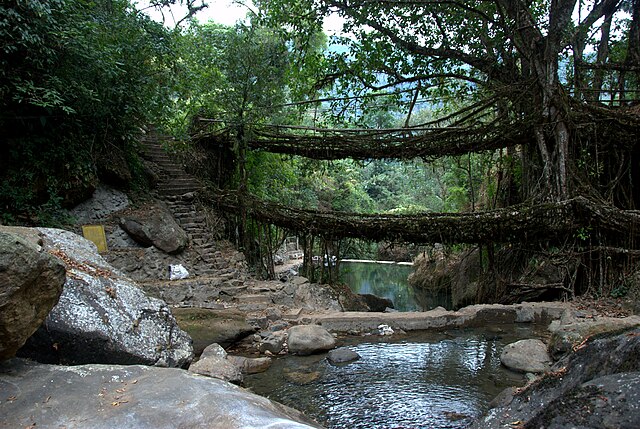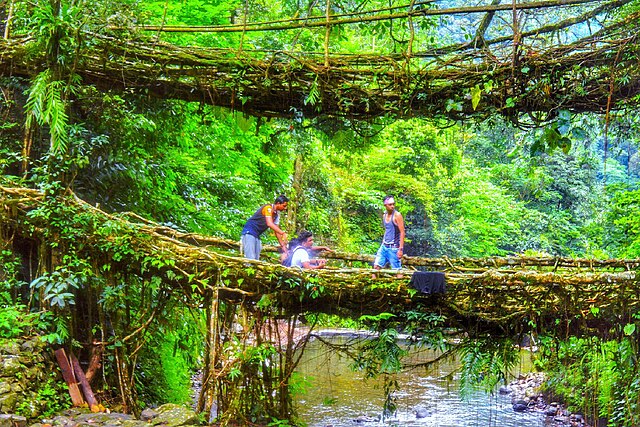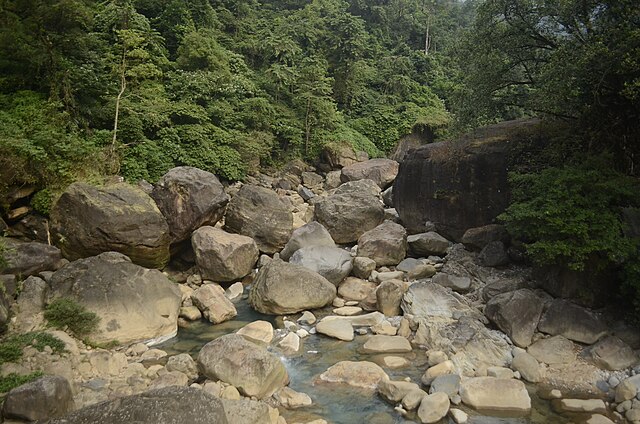Tucked away in the lush green hills of Meghalaya lies a village that seems straight out of a fairy tale. Have you ever wondered what it feels like to swim in crystal-clear pools surrounded by towering trees and ancient root bridges? Welcome to Nongriat – a hidden gem that’s quickly becoming every nature lover’s dream destination.
Nongriat isn’t just another village in Northeast India; it’s a testament to how humans and nature can coexist in perfect harmony. This small Khasi village has gained international recognition for its incredible living root bridges and pristine natural swimming pools that will leave you speechless.
What Makes Nongriat Special?
What sets Nongriat apart from countless other villages in India? The answer lies in its unique blend of natural wonders and human ingenuity that has been perfected over centuries.
The Famous Double Decker Living Root Bridge
The crown jewel of Nongriat is undoubtedly its Double Decker Living Root Bridge. This isn’t your typical man-made structure – it’s a living, breathing bridge created by training the roots of rubber trees over decades. The Khasi people have been perfecting this art for over 500 years, and the result is nothing short of magical.
Standing on this bridge feels like stepping into another world. The roots beneath your feet are strong enough to hold 50 people at once, yet they continue to grow and strengthen with each passing year. It’s like nature’s own version of sustainable architecture – something our modern world could definitely learn from.
Crystal Clear Natural Swimming Pools
But wait, there’s more! Just a short walk from the Double Decker Bridge, you’ll discover some of the most pristine natural swimming pools you’ve ever seen. These aren’t your typical muddy river pools – the water here is so clear you can count the pebbles at the bottom even when it’s 10 feet deep.
The most famous of these pools is at Rainbow Falls, where sunlight filtering through the canopy creates spectacular light shows in the mist. Swimming here feels like bathing in liquid crystal, and the experience is so surreal that many visitors describe it as life-changing.
Getting to Nongriat: Your Journey Begins
Planning your trip to Nongriat? The journey is part of the adventure, though it’s not for the faint-hearted. This hidden paradise requires some effort to reach, which is exactly why it remains unspoiled.
Route from Shillong to Nongriat
Your adventure begins in Shillong, the capital of Meghalaya. From Shillong, you’ll need to drive about 60 kilometers to reach Tyrna village – this journey takes roughly 2-3 hours depending on road conditions. The route passes through picturesque villages and offers stunning views of the Khasi hills.
From Tyrna, the real adventure begins. There’s no road to Nongriat – only a steep trek that descends about 2,500 steps into the valley. Think of it as nature’s own StairMaster, except the views get better with every step down.
The Trek Down: What to Expect
The trek to Nongriat is approximately 3 kilometers long and takes about 45 minutes to an hour for most people. Don’t let the distance fool you – those 2,500 steps down can be quite challenging, especially when you remember you’ll need to climb back up later!
The path winds through dense forests, across small streams, and past traditional Khasi villages. You’ll encounter friendly locals, curious chickens, and perhaps even some wild orchids if you’re lucky. The trek itself is an experience – like walking through a living, breathing National Geographic documentary.
Essential Items to Pack
What should you bring for this adventure? Here’s your essential packing list:
- Sturdy trekking shoes with good grip
- Water bottles (at least 2 liters per person)
- Quick-dry clothes and swimwear
- Waterproof bag for electronics
- First aid kit and personal medications
- Snacks and energy bars
- Portable phone charger/power bank
- Insect repellent and sunscreen
Where to Stay in Nongriat
Accommodation in Nongriat is beautifully simple and authentic. You won’t find luxury resorts here, but you’ll discover something far more valuable – genuine hospitality and a chance to live like the locals.
Homestay Options
The most popular way to stay in Nongriat is through homestays with local families. These aren’t fancy accommodations – think basic rooms with shared bathrooms and meals cooked over wood fires. But isn’t that exactly what makes it special?
Staying with a local family gives you insights into Khasi culture that no guidebook could provide. You’ll wake up to the sound of roosters, eat traditional meals, and learn about the ancient art of root bridge building from people who’ve been doing it for generations.
Camping Under the Stars
For the more adventurous souls, camping is another fantastic option. Several spots near the village offer safe camping areas where you can pitch your tent under a canopy of stars. There’s something incredibly humbling about falling asleep to the sound of flowing water and waking up to mist-covered mountains.
Best Time to Visit Nongriat
Timing your visit to Nongriat can make or break your experience. Each season offers something unique, so when should you plan your trip?
Monsoon Magic (June-September)
The monsoon season transforms Nongriat into a lush green paradise. The waterfalls are at their most spectacular, and the forest comes alive with vibrant colors. However, the trek can be slippery and challenging during heavy rains. If you don’t mind getting wet and love dramatic landscapes, this might be your perfect time.
Post-Monsoon Paradise (October-December)
This is arguably the best time to visit Nongriat. The rains have stopped, but the landscape is still lush and green. The waterfalls are flowing beautifully, the weather is pleasant, and the trek is manageable. It’s like getting all the benefits of monsoon beauty without the inconvenience of constant rain.
Winter Wonders (January-March)
Winter brings cooler temperatures and crystal-clear skies. While the waterfalls might be less dramatic, the swimming pools are still spectacular, and the clear weather makes for excellent photography. If you prefer cooler temperatures and don’t mind slightly less water flow, winter could be your ideal season.
Things to Do in Nongriat
What exactly can you do in this tiny village? Plenty, if you’re the type who finds joy in simple pleasures and natural wonders.
Swimming in Rainbow Falls Pool
Swimming in the natural pools of Nongriat is absolutely magical. The water temperature is perfect year-round, and the pools are deep enough for proper swimming yet safe enough for beginners. The main pool at Rainbow Falls is particularly spectacular – when sunlight hits the mist from the waterfall, you’ll understand why it’s called Rainbow Falls.
The water is incredibly refreshing after the trek down, and floating on your back while looking up at the forest canopy is a meditation in itself. It’s like having your own private infinity pool, except this one was designed by nature over millions of years.
Photography and Nature Walks

Nongriat is a photographer’s dream destination. Every corner offers Instagram-worthy shots, from the intricate patterns of the root bridges to the play of light and shadow in the forest. The golden hour here is particularly magical – the light filtering through the trees creates an almost ethereal atmosphere.
Best Photography Spots
Don’t miss these photogenic locations:
- The Double Decker Bridge at sunrise
- Rainbow Falls with morning light creating rainbows in the mist
- The natural pools with their crystal-clear reflections
- Traditional Khasi homes nestled in the forest
- The trek route with its stone steps disappearing into the jungle
Local Culture and Community
Nongriat isn’t just about natural beauty – it’s also about the incredible people who call this place home.
The Khasi Tribe Heritage
The Khasi people have been living in harmony with nature for centuries. Their traditional knowledge of sustainable living is evident everywhere – from the living root bridges to their farming practices. What’s particularly fascinating is their matrilineal society, where property and lineage are passed down through women.
Spending time with the locals gives you a glimpse into a way of life that prioritizes community and environmental stewardship over material wealth. It’s refreshingly different from our urban, consumer-driven lifestyles.
Traditional Food and Cuisine
The food in Nongriat is simple, healthy, and delicious. Most meals consist of rice, local vegetables, and sometimes fish or chicken. Everything is cooked fresh, often using ingredients grown right in the village. The Dal (lentils) here has a unique flavor thanks to the local spices, and the rice is some of the best you’ll ever taste.
Don’t miss trying the local brew – rice beer that’s mild and refreshing. It’s not for everyone, but it’s definitely a cultural experience worth having.
Safety Tips and Precautions
While Nongriat is generally safe, the remote location and challenging terrain require some precautions.
Trek Safety Guidelines
The trek down to Nongriat can be challenging, especially for those not used to hiking. Take your time, use the handrails where available, and don’t hesitate to rest when needed. The stone steps can be slippery when wet, so proper footwear is essential.
Always inform someone about your travel plans, carry enough water, and consider hiring a local guide if you’re not confident about the route. The locals are incredibly helpful and always willing to assist visitors.
Swimming Safety
While the natural pools are generally safe, always exercise caution. Don’t swim alone, be aware of the water depth, and watch out for slippery rocks. The current can be stronger than it appears, especially during monsoon season.
Budget Planning for Nongriat

Nongriat is refreshingly affordable, making it accessible to budget travelers and backpackers.
Accommodation Costs
Homestays typically cost between ₹500-1000 per person per night, including basic meals. Camping spots are even cheaper, usually around ₹200-500 per night. These prices make Nongriat one of the most budget-friendly destinations in Northeast India.
Food and Transportation Expenses
Transportation from Shillong to Tyrna costs about ₹2000-3000 for a shared taxi. Food in the village is extremely affordable – expect to spend ₹100-200 per meal. Overall, a 2-3 day trip to Nongriat can be completed for under ₹5000 per person, including all expenses.
Nearby Attractions
While Nongriat itself offers plenty to keep you busy, there are several other attractions in the area worth exploring.
Tyrna Village
Tyrna village, where your trek begins, is worth exploring. It offers beautiful views of the surrounding valleys and has several small shops where you can buy last-minute supplies. The village also has some excellent homestay options if you prefer to stay above the valley.
Other Living Root Bridges
The area around Nongriat has several other living root bridges, each with its own unique character. The Single Decker Bridge is just a short walk from the Double Decker and offers a more intimate experience. There’s also a newer bridge under construction – watching the locals train the roots is fascinating.
Conclusion
Nongriat represents everything that’s beautiful about travel – the joy of discovery, the warmth of human connection, and the humbling power of nature. This tiny village in Meghalaya offers experiences that money can’t buy in the developed world: crystal-clear swimming pools created by nature, bridges grown from living trees, and a community that welcomes strangers as family.
Yes, getting to Nongriat requires effort. You’ll sweat on the trek down, your legs will ache on the climb back up, and the accommodation is basic. But isn’t that exactly what makes it special? In our Instagram-filtered world, Nongriat offers something increasingly rare – an authentic, unpolished experience that changes you from the inside out.
Whether you’re seeking adventure, tranquility, or simply a break from the modern world, Nongriat delivers in spades. It reminds us that the best destinations aren’t always the easiest to reach, and sometimes the journey truly is as important as the destination.
Frequently Asked Questions
1. How difficult is the trek to Nongriat?
The trek to Nongriat involves descending about 2,500 stone steps and takes 45-60 minutes. While not technically difficult, it requires moderate fitness levels. The return journey uphill is more challenging and can take 1-1.5 hours. People with knee problems or heart conditions should consult a doctor before attempting the trek.
2. Can I visit Nongriat as a day trip?
While technically possible, a day trip to Nongriat is not recommended. You’ll spend most of your time trekking up and down, leaving little time to enjoy the pools and bridges. Most visitors stay at least one night to fully experience the village and rest before the uphill climb.
3. Is it safe to swim in the natural pools?
Yes, the natural pools in Nongriat are generally safe for swimming. The water is clean and the depth is manageable for most swimmers. However, always swim with a buddy, be cautious of slippery rocks, and avoid swimming during heavy rains when the current can be stronger.
4. What’s the best way to book accommodation in Nongriat?
Homestay bookings can be made through local contacts or online platforms, but many visitors simply arrive and find accommodation on the spot. The villagers are welcoming and usually have space available. However, during peak season (October-December), it’s advisable to book in advance.
5. Are there ATMs or mobile network coverage in Nongriat?
No, there are no ATMs in Nongriat, so carry sufficient cash for your entire trip. Mobile network coverage is patchy and unreliable. This digital detox is actually part of the charm – it forces you to truly disconnect and immerse yourself in the natural beauty and local culture.

